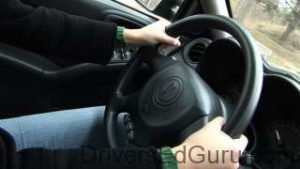Stage 1: Steering Methods

You should always have two hands on the steering wheel.
Many of us have been known to use one hand to steer while using the other to chat on a cellphone, adjust the radio, or eat a burger. And trust me, your teen has seen you do this.
So use proper steering as the first (of potentially many) instances where you confess to your teen that some of your driving habits aren’t quite up to snuff.
Explain that you want them to learn proper driving habits because you’re concerned about their safety and that you’ll try to shore up your bad habits as well. A little honesty never hurt anybody.
While driving, your hands should rest comfortably at 10 and 2 on the wheel (or thereabouts depending on what is comfortable). If you need to make a turn, you can use one of the following methods. Keep in mind that regular driving requires using multiple methods, depending on the situation.
Hand-over-hand method
As the name suggests, your hands are going to cross each other while turning the wheel.
If making a right turn:
- Grip the wheel with your left hand and turn it towards your right hand.
- At the same time, your right hand will release from the wheel and cross over your left hand. Re-grip the wheel with your right hand and continue turning.
The hand-over-hand method turns the wheel a great distance in a relatively short period of time. Therefore, this method is typically used when making sharp turns (such as a U-turn) and when driving at slow speeds. When driving slowly, more steering input is required to turn your vehicle.
While this method is popular, it isn’t as safe as the hand-to-hand method. In fact, some countries have outlawed hand-over-hand steering. It also exposes you to additional risk of injury to arms, hands, and face if the airbag deploys.
Hand-to-hand or “pull-push-slide” method
With the hand-to-hand (sometimes known as as the pull-push-slide) steering method, your hands do not cross each other.
Each hand remains on its respective side of the wheel.
When turning left:
- Your left hand begins by pulling in a downward motion from the 10 o’clock position to the 9 o’clock position.
- Nearly simultaneously, your right hand slides down to the 7 o’clock position. You don’t want to turn the wheel, you’re simply moving your hand from the 2 o’clock position to the 7 o’clock position. By sliding, you’re maintaining readiness on the wheel.
- Stop pulling with your left hand.
- Use your right hand to push the wheel “up”. Your hand will move from the 7 o’clock position to the 2 o’clock position.
- Return your left hand to the 10 o’clock position.
Turning right is performed by starting with your right hand.
The hand-to-hand method works well for highway driving where minimal steering input is required. Many people like this steering method, because both hands are usually even with each other and they never leave the wheel (as with the hand-over-hand method).
Fixed hands
We debated even mentioning this steering method because, well, it has pretty limited use. As the name suggest, your hands stay fixed at 10 and 2. You then turn your arms about 15-20 degrees (yes, your hands will move, but not relative to their starting position on the wheel). Obviously, this doesn’t produce much steering input, so it is typically reserved for high-speed driving. Race car drivers use this steering method.
Steering “Dont’s”
- Don’t let the steering wheel spin freely. Many of us have done this, especially after completing a turn. However, it’s not a good idea to ever take both hands off your steering wheel. We think it’s pretty obvious as to why.
- Don’t put your hands inside of the steering wheel. Many right-handers do this with their right hand when making a left turn. They put their hand inside the wheel and grip the top of the wheel with their palm facing their face. Some people thinks this gives them more leverage for turning. Power-steering makes turning the wheel so easy that you should never need to do this.
- Don’t steer with one hand…or your knee. Your teen has probably seen you do this, so make sure you explain to them that it’s dangerous. Despite the fact that you’ve probably gotten “away” with this steering method without any consequences doesn’t mean it’s the correct way to steer. Check out our “Do what I say, not what I do” article.
Continue on to Become a Parking Expert

